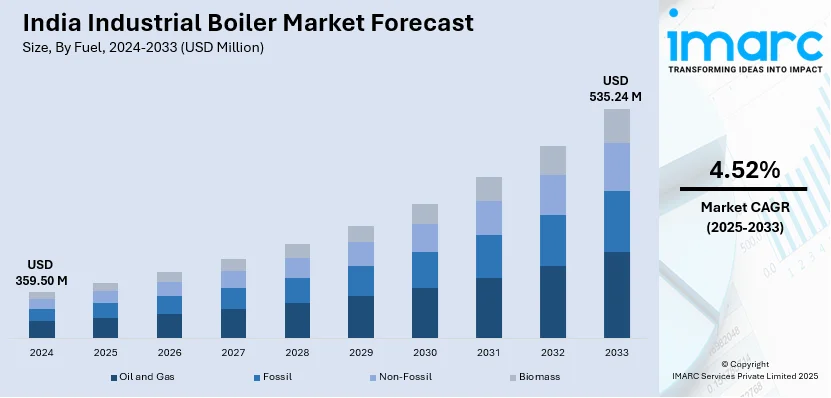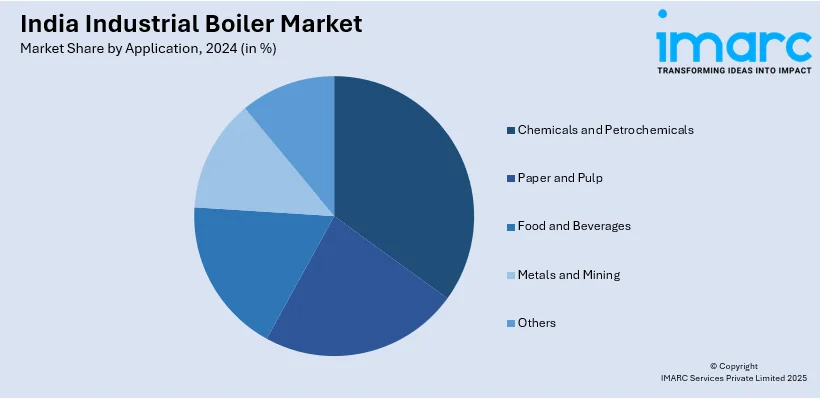
India Industrial Boiler Market Size, Share, Trends and Forecast by Application, Fuel, and Region, 2025-2033
India Industrial Boiler Market Overview:
The India industrial boiler market size reached USD 359.50 Million in 2024. Looking forward, IMARC Group expects the market to reach USD 535.24 Million by 2033, exhibiting a growth rate (CAGR) of 4.52% during 2025-2033. The market is witnessing significant growth due to the widespread adoption of energy-efficient and low-emission boiler and expansion of industrial infrastructure, which is driving the demand for high-capacity boiler.
|
Report Attribute
|
Key Statistics
|
|---|---|
|
Base Year
|
2024 |
|
Forecast Years
|
2025-2033
|
|
Historical Years
|
2019-2024
|
| Market Size in 2024 | USD 359.50 Million |
| Market Forecast in 2033 | USD 535.24 Million |
| Market Growth Rate (2025-2033) | 4.52% |
India Industrial Boiler Market Trends:
Rising Adoption of Energy-Efficient and Low-Emission Boiler
Currently, the Indian industrial boiler market displays a phenomenal shift towards energy efficient and low-emission boiler systems due to increased environmental concerns and stringent regulatory conditions. Under the national mission on increased energy efficiency, the Perform, Achieve and Trade (PAT), the government of India is compelling industries toward efficient energy use. It is promising to realize a huge future increase in the demand for high-efficiency boiler. Traditional coal-fired boiler are gradually being replaced with natural gas, biomass and hybrid boiler, which have better combustion efficiency and much lower emission carbon. More importantly, WHRBs are currently to be very convincing as industries engaged in process throw out exhaust heat from their services want to recover that exhausted heat and save the expenses through making their operations more sustainable. Under the Environment (Protection) Act, 1986, the government imposes stricter emission standards; all of this has seen industrial players investing more into low NOx and SOx boiler to comply with these norms. For instance, in February 2025, Parliament is advancing the Boiler (Amendment) Bill, 2024, replacing the 1923 Act to regulate industrial boiler, standardize operations, and enhance safety through construction norms, pressure limits, registration, and periodic inspections. Technological advancements, such as modular boiler designs, digital monitoring systems, and AI-driven performance optimization, are further enhancing operational efficiency and driving adoption. As industries prioritize sustainability and cost reduction, the demand for clean and energy-efficient boiler is expected to grow significantly, making them a cornerstone of India's industrial heating solutions.

Expansion of Industrial Infrastructure Driving Demand for High-Capacity Boiler
The expansion of industrial infrastructure across manufacturing, chemicals, food processing, and power generation sectors is fueling the demand for high-capacity and customized industrial boiler in India. The government’s push for Make in India, along with infrastructure-led programs like the Production-Linked Incentive (PLI) scheme and the National Infrastructure Pipeline (NIP), is accelerating industrial investments. Sectors such as steel, cement, petrochemicals, and pharmaceuticals are expanding their production capacities, necessitating advanced boiler systems with higher steam output and superior thermal efficiency. Additionally, India’s rapid urbanization and increasing energy needs are prompting investments in power plants, district heating networks, and cogeneration systems, further driving the demand for industrial boiler with high-pressure steam capabilities. For instance, in February 2025, NTPC and NTPC Green Energy announced its plans to invest over $23 billion in Madhya Pradesh for 20GW renewable projects, including solar, wind, and pump hydro, through MoUs with the state government. Companies are focusing on customized boiler solutions tailored to specific industry requirements, integrating automation, IoT-based predictive maintenance, and smart control systems to enhance reliability and performance. With industrial expansion accelerating, the India industrial boiler market is expected to witness substantial growth, supported by strong capital investments and the need for high-performance, scalable, and sustainable boiler technologies.
India Industrial Boiler Market Segmentation:
IMARC Group provides an analysis of the key trends in each segment of the market, along with forecasts at the region level for 2025-2033. Our report has categorized the market based on application and fuel.
Application Insights:

- Chemicals and Petrochemicals
- Paper and Pulp
- Food and Beverages
- Metals and Mining
- Others
The report has provided a detailed breakup and analysis of the market based on the application. This includes chemicals and petrochemicals, paper and pulp, food and beverages, metals and mining, and others.
Fuel Insights:
- Oil and Gas
- Fossil
- Non-Fossil
- Biomass
A detailed breakup and analysis of the market based on the fuel have also been provided in the report. This includes oil and gas, fossil, non-fossil, and biomass.
Regional Insights:
- North India
- South India
- East India
- West India
The report has also provided a comprehensive analysis of all the major regional markets, which include North India, South India, East India, and West India.
Competitive Landscape:
The market research report has also provided a comprehensive analysis of the competitive landscape. Competitive analysis such as market structure, key player positioning, top winning strategies, competitive dashboard, and company evaluation quadrant has been covered in the report. Also, detailed profiles of all major companies have been provided.
India Industrial Boiler Market News:
- In December 2024, Forbes Marshall, a Pune-based multinational with an $200 million turnover, continues to retain its position a leader in industrial automation. Its Multiparameter Analyser for effluent treatment plants (ETPs) automates chemical dosing, improving efficiency. The company specializes in steam engineering systems and process automation controls, driving industrial innovation.
- In September 2024, Thermax announced partnership with Ceres Power to manufacture and commercialize solid oxide electrolysis cell (SOEC) technology for green hydrogen production. This collaboration enables 25% higher efficiency than conventional electrolysis, utilizing industrial waste heat. The initiative targets decarbonizing hard-to-abate industries, including steel, refineries, fertilizers, and chemicals globally.
India Industrial Boiler Market Report Coverage:
| Report Features | Details |
|---|---|
| Base Year of the Analysis | 2024 |
| Historical Period | 2019-2024 |
| Forecast Period | 2025-2033 |
| Units | Million USD |
| Scope of the Report |
Exploration of Historical Trends and Market Outlook, Industry Catalysts and Challenges, Segment-Wise Historical and Future Market Assessment:
|
| Applications Covered | Chemicals, Petrochemicals, Paper, Pulp, Food and Beverages, Metals, Mining, Others |
| Fuels Covered | Oil and Gas, Fossil, Non-Fossil, Biomass |
| Regions Covered | North India, South India, East India, West India |
| Customization Scope | 10% Free Customization |
| Post-Sale Analyst Support | 10-12 Weeks |
| Delivery Format | PDF and Excel through Email (We can also provide the editable version of the report in PPT/Word format on special request) |
Key Questions Answered in This Report:
- How has the India industrial boiler market performed so far and how will it perform in the coming years?
- What is the breakup of the India industrial boiler market on the basis of application?
- What is the breakup of the India industrial boiler market on the basis of fuel?
- What is the breakup of the India industrial boiler market on the basis of region?
- What are the various stages in the value chain of the India industrial boiler market?
- What are the key driving factors and challenges in the India industrial boiler?
- What is the structure of the India industrial boiler market and who are the key players?
- What is the degree of competition in the India industrial boiler market?
Key Benefits for Stakeholders:
- IMARC’s industry report offers a comprehensive quantitative analysis of various market segments, historical and current market trends, market forecasts, and dynamics of the India industrial boiler market from 2019-2033.
- The research report provides the latest information on the market drivers, challenges, and opportunities in the India industrial boiler market.
- Porter's five forces analysis assist stakeholders in assessing the impact of new entrants, competitive rivalry, supplier power, buyer power, and the threat of substitution. It helps stakeholders to analyze the level of competition within the India industrial boiler industry and its attractiveness.
- Competitive landscape allows stakeholders to understand their competitive environment and provides an insight into the current positions of key players in the market.
Need more help?
- Speak to our experienced analysts for insights on the current market scenarios.
- Include additional segments and countries to customize the report as per your requirement.
- Gain an unparalleled competitive advantage in your domain by understanding how to utilize the report and positively impacting your operations and revenue.
- For further assistance, please connect with our analysts.
 Inquire Before Buying
Inquire Before Buying
 Speak to an Analyst
Speak to an Analyst
 Request Brochure
Request Brochure
 Request Customization
Request Customization




.webp)




.webp)












